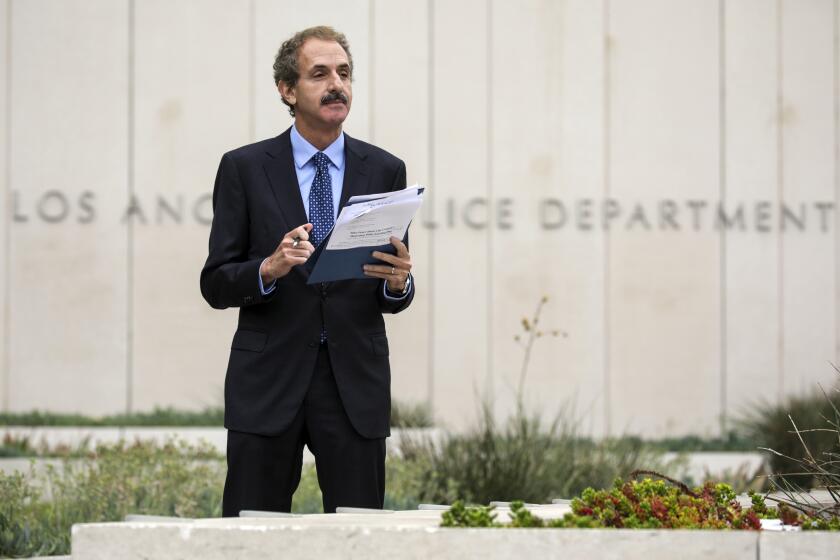Plan to Revise Workers’ Benefits Opposed : Finances: Organized labor and Democratic legislators are against governor’s proposal to overhaul the state’s system for compensation as part of budget negotiations.
A proposal by Gov. Pete Wilson to overhaul two key provisions of the state’s $10-billion workers’ compensation system may be imperiled by opposition from organized labor and its Democratic allies in the Legislature.
Wilson offered the proposal and linked it to the budget negotiations as a way to appease business interests upset by his support of nearly $7 billion in tax increases. But it now appears that Wilson will get at best only part of his package and may have to wait until after the budget is resolved to negotiate a more comprehensive overhaul of the system.
“It’s an uphill battle,” acknowledged Bill Livingstone, Wilson’s press secretary.
Administration officials contend that the proposal would cut nearly $700 million from the privately funded workers’ compensation system by making it harder for workers to collect disability payments for stress and by ending what they believe are double payments to injured workers undergoing vocational rehabilitation. Half of the savings would be returned to qualifying workers in the form of higher benefits and half would be used to reduce the premiums paid by employers.
“The issue is competitiveness,” said William Campbell, president of the California Manufacturers Assn. and a strong supporter of the proposal. “You can’t just increase taxes without expecting to have an adverse impact on the economy of this state unless you somehow offset that tax increase.”
But union officials and others say the proposal would unfairly restrict the rights of injured workers. Rehabilitation therapists say the package might save money for business but probably would increase state costs for social services to injured workers.
“This is just a money-saving device for business,” said John Henning, executive secretary-treasurer of the California Labor Federation, which opposes the proposal. “We can’t believe that any corporation is going to leave the state because of the workers’ compensation law.”
Administration officials and backers of the proposal insist it is still on the negotiating table and likely to be included in the final budget package. Opponents say they believe workers’ compensation has been removed from the budget negotiations and will not be addressed, if at all, until later in the year.
Wilson’s proposal is a follow-up to a 1989 measure that sought to overhaul the workers’ compensation system by boosting benefits for injured employees while tightening eligibility standards. However, business interests now say those changes are not producing the desired savings.
The most controversial part of the governor’s plan is a proposal to make it significantly harder for workers to obtain disability benefits for stress caused by their jobs.
Under existing law, workers seeking to collect disability for psychiatric injuries are required only to show that at least 10% of their stress resulted from actual events in the workplace. They must prove this with a “preponderance of evidence”--the equivalent of saying that the majority of the evidence supports their claim.
The Wilson proposal would raise these standards and add one. It would require that at least half of a worker’s stress be because of events on the job. And workers would have to supply “clear and convincing” evidence--a higher level of proof exceeded only by the standard of “beyond a reasonable doubt” required in criminal cases.
In addition, the worker would have to show the stress was caused by “sudden and extraordinary” events--as opposed to the routine conditions of employment or stressful conditions that built up over a period of years.
Business groups say stress claims are increasing rapidly and now consume about 3.7% of the total costs in workers’ compensation, or about $370 million annually. Supporters estimate at least half of those costs could be eliminated.
“There has been considerable abuse,” said Harry Sunderland, a vice chairman of Safeway Stores and one of the architects of the governor’s proposal. “There is stress from so many directions on people today that we think employers are having to pay for stressed-out employees where very little, if any, of the stress is related to the job.”
While the changes are important to private sector employers, they would probably have the most impact on public employees, especially law enforcement officers and other public safety workers seeking compensation for what are generally acknowledged as high rates of burnout. Jeff Thompson, a lobbyist for the state prison guards association, said stress is a “legitimate injury” for which correctional officers and others in law enforcement should be compensated.
“There are incidents where there is blood all over the place, where a couple people get stabbed,” Thompson said. “Over a period of 10 or 15 years, that kind of thing is something you can’t ignore. It takes wear and tear on the body and you’ve got to deal with it.”
The other part of the governor’s proposal would combine vocational rehabilitation and permanent disability benefits. Under existing law, workers in therapy receive vocational rehabilitation benefits. Later, they may obtain permanent disability payments if the injury leaves them impaired for life. Under the governor’s plan, workers who chose to undergo therapy would have their vocational rehabilitation benefits deducted from any permanent disability payments they might eventually receive.
Supporters say this change would encourage workers to more quickly complete their therapy and return to the workplace, because every day they spend in rehabilitation would take away from benefits they receive later. Opponents argue that the change would only encourage workers to forgo rehabilitation as part of workers’ compensation, seek therapy elsewhere and accept their disability payments in full.
More to Read
Get the L.A. Times Politics newsletter
Deeply reported insights into legislation, politics and policy from Sacramento, Washington and beyond. In your inbox three times per week.
You may occasionally receive promotional content from the Los Angeles Times.






